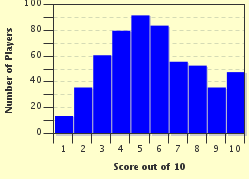Quiz Answer Key and Fun Facts
1. Both classical and instrumental methods can be used to determine the concentration of a specific element or species in a compound. Which of the following pairs is the WRONG combination of the type of analysis with its characteristic?
2. The unit molarity (mole per liter) is used to express the concentration of a certain species of chemical element in a concentrated solution. Meanwhile, other more appropriate units are more commonly used to describe the concentration of more diluted solutions. One of these units, which is very close to the milligram per liter measurement, is?
3. Many statistical tests are performed for the data obtained in analytical chemistry. One of the tests decides whether a given datum (either the value is too big or too small compared to the other data) can be rejected or not. This test is?
4. In chemical equilibrium, a principle states that if a stress (for example, a change in concentration, pressure, temperature or volume of the vessel) is applied to a system in equilibrium, the equilibrium will shift in such a way to lessen the effect of the stress. This principle is called?
5. Amphoteric salts, also known as amphiprotic salts, are often used in the preparation of buffer solutions. An amphoteric salt can act as an acid or a base, depending on the values of its dissociation constants. Which of the followings is (are) an amphiprotic molecules(s)?
6. In acid-base titration in analytical chemistry, the Kjeldahl method involves dissolution of a substance in sulfuric acid, treatment with sodium hydroxide and also back titration using hydrochloric acid. It was developed by Johan Kjeldahl and is used to determine the percentage of a specific element in chemical compounds. Which element is it?
7. In complexometric titration, the most common used chelating agent is EDTA (ethylenediamine tetraacetic acid). EDTA's molecules will combine with metals to form chelate. EDTA is classified as a?
8. The gravimetric analysis involves preparation of solution, digestion, filtration, washing, drying, weighing and igniting. The term analyte refers to the elements that we are interested in the analysis. What is the term that is used to refer to the other elements or species that we are not interested in?
9. All of the following methods are used for the analysis of precipitate, EXCEPT?
10. In redox titration, what chemical substance is added to the iodometry and iodimetry analysis?
Source: Author
Matthew_07
This quiz was reviewed by FunTrivia editor
crisw before going online.
Any errors found in FunTrivia content are routinely corrected through our feedback system.

